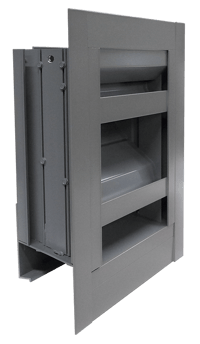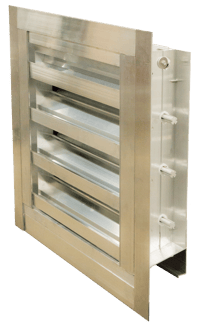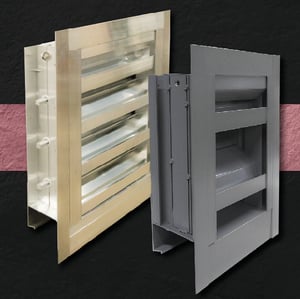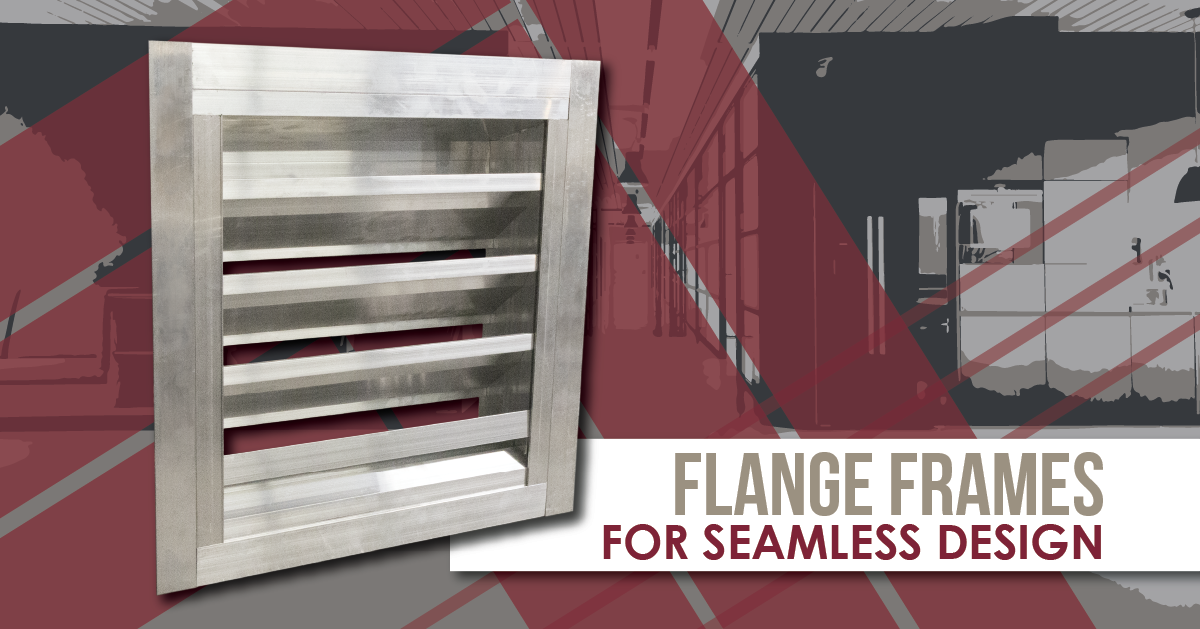A flange frame can create a seamless look along the face of a building. But how does it work? Learn more in this Condenser article.
Designing with Louvers
Imagine you're designing the envelope of a building, and you need to add intake louvers to the design. You want to keep the building's seamless look, but the louvers you need will create harsh square shapes along the envelope. Even with a custom finish, the seams made by the louvers stick out like a sore thumb. There is a way to hide these harsh lines and keep the design flat. Consider adding flange frames to these louvers.
.png?width=425&height=481&name=EA-415-D%20with%20Flange%20(Resize).png)
Need louvers for an upcoming project? Contact Arrow United Industries today. We can help you find the right louvers to meet your project's requirements.
Standard vs. Flange
 A standard louver frame sits inside the opening. When louvers are installed with a standard frame, the edges of the frame are visible within the opening of the wall. This creates a clear seam between the wall and the louver. Installers will typically apply caulk to the seam to complete the installation. This is fine for functional purposes, but it may not be the aesthetic you're looking for.
A standard louver frame sits inside the opening. When louvers are installed with a standard frame, the edges of the frame are visible within the opening of the wall. This creates a clear seam between the wall and the louver. Installers will typically apply caulk to the seam to complete the installation. This is fine for functional purposes, but it may not be the aesthetic you're looking for.
Flange frames can cover these seams. They have a thin piece attached to the face of the louver, known as the flange. This flange extends past the face and along the wall. When installed, flanges sit flat against the wall and cover the seams of the opening, creating a seamless aesthetic between louver and building.
A Flange for All Sides
 Most flange frames have flanges on all sides to fully cover the seam of the opening. This creates a uniform look for the frame and completely hides the seam from view. However, you can add flanges individually to the head, sill, and jambs of a louver. You can install a louver with flanges on the jambs of the louver, leaving the head and sill exposed. Any combination of flanges will work!
Most flange frames have flanges on all sides to fully cover the seam of the opening. This creates a uniform look for the frame and completely hides the seam from view. However, you can add flanges individually to the head, sill, and jambs of a louver. You can install a louver with flanges on the jambs of the louver, leaving the head and sill exposed. Any combination of flanges will work!
Choosing where flanges go depends on the aesthetic you want with your building's surfaces. You may want to keep the horizontal lines created by the louver's opening. Or you may want to hide these lines from view, to achieve that seamless look. It all depends on your designs.
When Aesthetic is Key
 Flanges add weight to the louver’s frame and require special installation methods. Also, consider that larger louvers will also have larger, heavier flanges. Flange frames do not affect a louver's air performance or its water penetration capabilities. Flanges sit along the sides of the louver, away from the louver's face, and do not obstruct the louver's free area.
Flanges add weight to the louver’s frame and require special installation methods. Also, consider that larger louvers will also have larger, heavier flanges. Flange frames do not affect a louver's air performance or its water penetration capabilities. Flanges sit along the sides of the louver, away from the louver's face, and do not obstruct the louver's free area.
Flange frames give an aesthetic touch to a louver’s design. Whether to use them or not depends on how you want your building to look. You may want the louver to sit alone in the opening with the seams clearly visible, or you may have multiple louvers linked together that cannot have individual flanges. A flange frame on all sides would look good on your building. The choice is up to you. There are several ways to turn your louvers into works of art.
To summarize, flange frames cover the seams created by ventilation openings. You can add them to any side of the louver: jambs, sill, or head, on the face or back side. They add weight to the louver and require special instructions to install. Consider adding flanges to your louver's frame to create a seamless look.
For more on accessories and other options, check out these Newsstand articles:
What do you think of flange frames? Would you add them to your louvers? Have you used a flange frame in a project before? Share your thoughts in the Comments section. MCDLG wants to know!
.webp?width=91&height=70&name=MCDLG%20Logo%20(Resize).webp)





